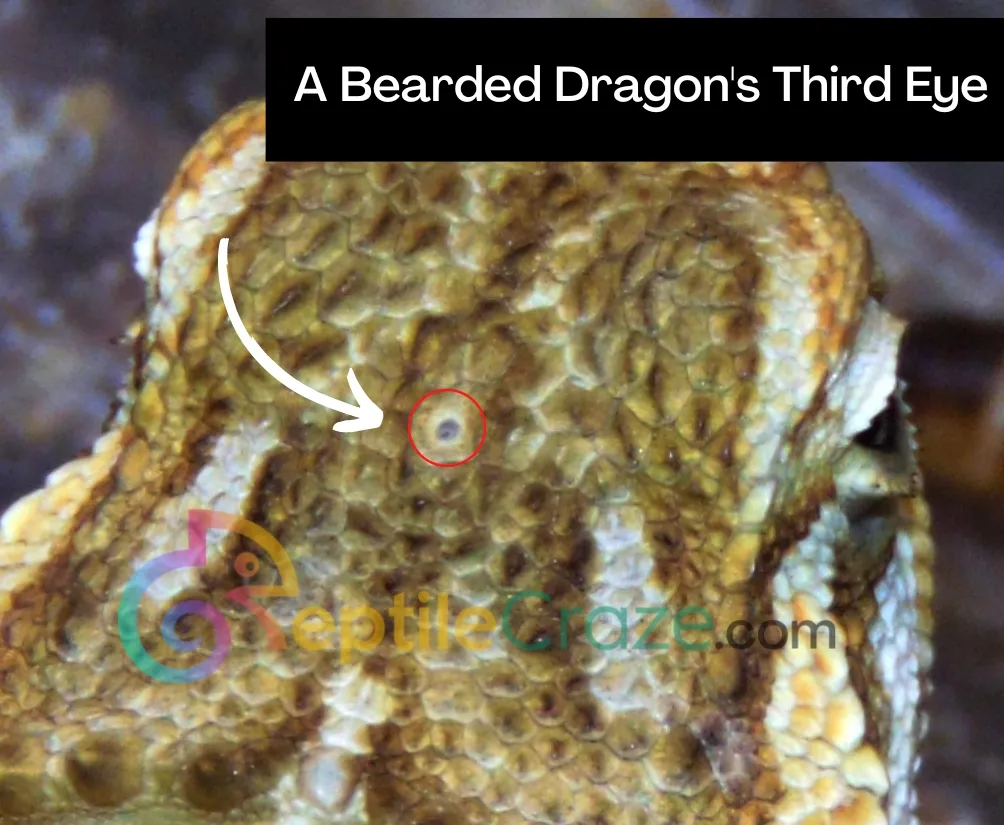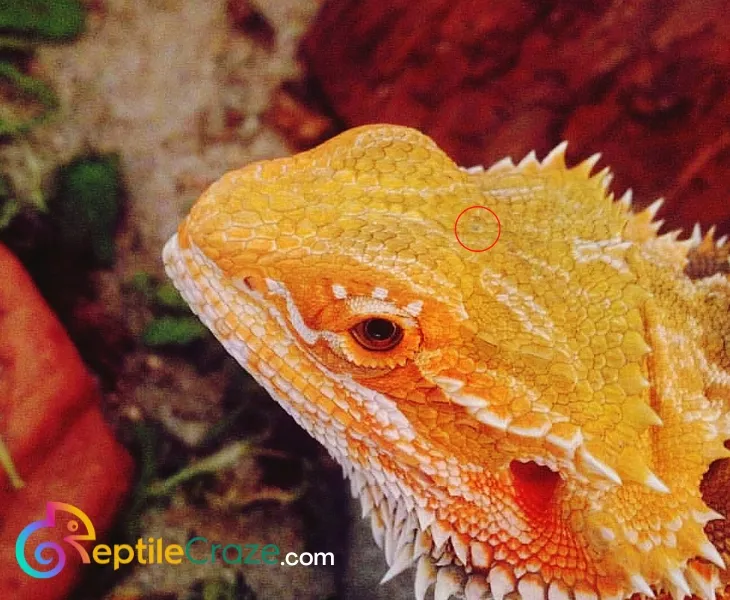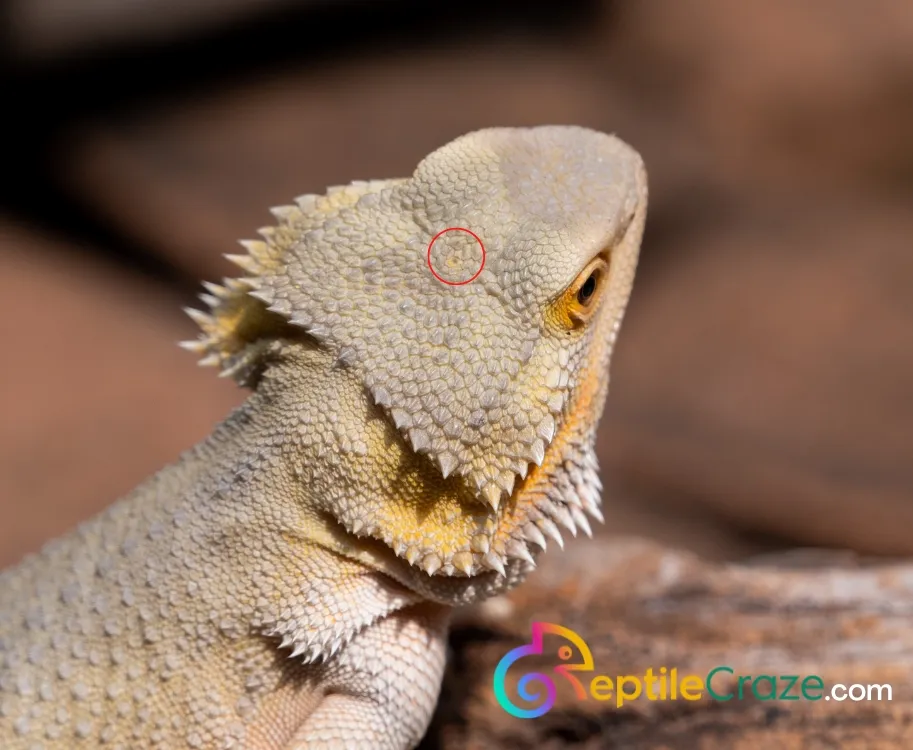
Did you know that bearded dragons have a ‘parietal’ or ‘third’ eye? The parietal eye (sometimes wrongly called ‘pineal eye’), has a few important functions.
The third eye does not have a purpose related to vision as we know it. Instead, the third eye helps bearded dragons by sensing environmental conditions such as temperature and shade. The third eye also influences a beardie’s orientation and hormonal processes.
In this article we’ll explain the structure, function and specific care needs of a bearded dragon’s third eye. We’ll also compare how it’s different to a beardie’s normal (or ‘lateral’) eye.
Table of Contents
What Is The Third Eye?
Despite sharing it’s name and some structural components, the third eye is not actually used for vision. Scientists hypothesize that the parietal eye helps Beardies survive in a variety of places, such as extremely warm areas.
Gundy et al note that ‘the overall significance of the parietal eye to lizards as a group is that it facilities survival at higher latitudes’.
A Close Up Of A Bearded Dragon’s Third Eye

As you can see in this close-up. The third eye of a bearded dragon looks like a black dot. There is nothing that would make you think that this is an eye.
What Is The Function Of A Bearded Dragon’s Third Eye?
According to some scientists, more research on the purpose of the parietal eye needs to be done as ‘the true function of this organ remains a mystery’.
Some of the theories regarding the function of the parietal eye include:
- Assisting with Orientation
- Detecting light and hence affecting temperature regulation
- Hormonal changes.
1. Orientation
Scientists have found evidence to suggest that lizards use their third eye to assist with orientation and their sense of direction. In an interesting study, Quinn et al, covered the parietal eye of a lizard (Yarrow’s spiny lizard) and released them.
According to their study, the lizards whose parietal eye remained uncovered after being transported away from home were more likely to find their way back home. The individuals who had their parietal eye covered, were not as good at finding their way home.
2. Light Detection
Special cells called ‘photoreceptor cells’ enable the parietal eye to detect shadows from above. In nature, this could help bearded dragons respond to threats from potential predators.
Tip: when handling your Beardie, be careful not to approach them from above incase they misinterpret your hand for danger and become scared.
3. Temperature Regulation

Bearded dragons are ectotherms, which means they depend on the external environment to adjust their body temperature.
If they’re too cold, they will move into a warmer area (such as in the sun). If they’re too warm, they’ll move into a cooler area (such as in the shade).
Since the parietal eye can detect light and shade, it helps them to optimize their body temperature by moving towards or away from more sunny and warmer areas as needed.
This links back to the point that was made earlier about beardies being able to survive in higher latitudes.
Studies in other lizard species have found that the removal of their parietal eye affects their ability to sleep.
You can read more about thermoregulation in our article ‘Can Bearded Dragons Overheat?’.
4. Hormonal Importance
Both the parietal eye and a structure called the pineal gland (which is attached to the parietal eye) produce melatonin.
The pineal gland is a structure within the brain that affects sleep cycles and produces melatonin. Melatonin is produced more when light is decreased and is important for sleep.
Studies have also described the importance of the hormone melatonin in thermoregulation and reproduction.
What Is The Structure Of The Third Eye?
The third eye has the following structural components which can also be found in ‘lateral eyes’:
- Cornea
- Lens
- Retina
It also contains special cells called ‘photoreceptor cells’ which are similar to the ‘cone’ cells found in lateral eyes.
How Is It Different To A Normal or ‘Lateral’ Eye?
To make it easier to compare the two, we’ve summarised the key differences between the parietal eye and the lateral eyes in the table below.
| Lateral Eye | Parietal Eye |
| Located in the orbit | Located in the parietal foramen |
| 2 per individual | 1 per individual (apart from lampreys – they have 2) |
| Present in all mammals | Present in lizards, frogs, some fish and lampreys |
| Usually can easily be seen | Can be seen if you look closely |
| Has ‘cone’ and ‘rod’ cells to detect light | Uses special photoreceptors to detect light |
| Eyelids present | No eyelids present |
Does The Third Eye Need Special Care?

Satisfying your Bearded Dragon’s needs in terms of care and husbandry is the best way to keep them and their parietal eye in good condition.
It’s important to control and monitor the following parameters in your bearded dragon’s enclosure:
- Light
- Temperature
- UV
- Humidity
Also, be sure to clean and disinfect your Beardie’s enclosure and components (such as their plants) regularly.
It’s good to remember that, like the lateral eye, the parietal eye is a delicate structure. So it’s probably best not to touch or poke it.
Aside from that, to avoid stressing your pet, try not to approach them from above during handling or feeding. This movement could be threatening for a Bearded Dragon.
If you want to read about other behavior which could upset your beardie, read our article ‘What do bearded dragons hate?’.
Summary
The parietal eye has important roles in a beardie’s survival. From warning them about predators, to influencing physiological processes, bearded dragons would be lost without it, literally!
- Enchi Ball Python: A Unique and Stunning Morph of Python regius - March 27, 2025
- Emerald Tree Monitor: The Enigmatic Green Guardian of the Rainforest - March 26, 2025
- The Egyptian Cobra (Naja haje): A Fascinating Serpent - March 25, 2025
